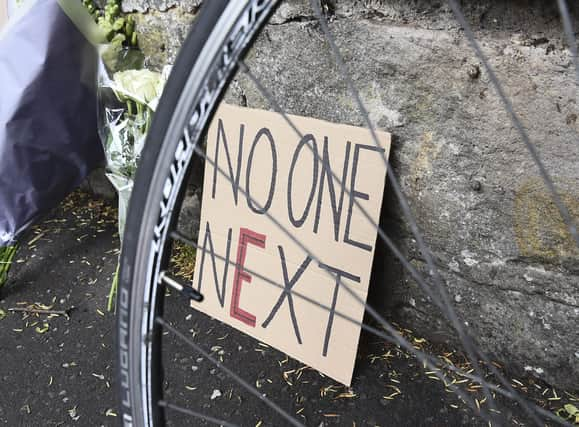How Edinburgh can cut pedestrian and cyclist road deaths to zero – Anthony Robson


As the country slowly, but surely, gets back to whatever normal is destined to be, some old pre-lockdown issues have re-emerged. With roads becoming as busy as they ever were, is it time to re-assess how we travel, in order to be safe?
The second half of June saw a particularly dark period on Edinburgh’s roads and pavements. Four major incidents saw two people killed and another two seriously injured. James Harrison, a nurse who had been volunteering in an intensive care ward, was cycling when he was killed in a collision with a van. Meanwhile, in horrific circumstances less than a week later, three-year-old Xander Irvine lost his life on the pavement in Morningside, after a car mounted the kerb, striking him and his mother.
Advertisement
Hide AdAdvertisement
Hide AdThe initial reaction to these types of incidents is, understandably, sadness. You don’t have to know someone to have empathy wash through you, and whether a cyclist or a pedestrian, that dread sense of “it could have been me” can’t be escaped. However, this time there seemed a shift in emotion. That grief was still present, but I found myself also mired in frustration and anger.


Three of the incidents took place on 20mph roads. Two cyclists, including James, had their incidents on roads which during not just lockdown, but in the years preceding it, had been highlighted as potentially unsafe. Two young pedestrians were struck on streets which were earmarked for yet-to-be-implemented parking bans to allow more space for people to move about safely.
I found that I wasn’t the only person who was angry. The realisation coalesced within me into a desire to try, in my own small way, to make my city a safer place to be. Productive anger, because anger is not a one-dimensional emotion and can certainly be turned to the good.
And so, the day before a vigil took place for James Harrison, a week to the day since he was killed, I asked people for a simple thing: change their profile picture on Twitter to a red circle, with a white “E” within it. E for Enough.
It came with a message to send to councillors – that this wasn’t a group of people who could be dismissed out of hand as “hard-left” protesters or the oft-reviled “cycling lobby”. This was, and is, a random collection of people whose only extreme view is that others should not be killed and injured on the city’s roads and pavements.
It seems almost ridiculous to think that this can be seen as a negative aim, that a pigeon-hole for avoidance can be so easily assigned. However, when people are used to the status quo it can seem like a change is, in many ways, an assault on freedoms. That is especially the case when messages aren’t received about the benefits of those changes.
While “not being killed” should be reason enough to convince people of the merits of a scheme, it seems they want more. At the same time, that “more” is often drowned out by traffic noise.
Anywhere that puts in more measures for people who walk, cycle or use public transport, with a concurrent reduction in car use, meets resistance. It happens the world over. And the world over, given time, there is an almost universal acceptance that things have improved. Local areas, local shops, are more vibrant. People can hear each other talk in the streets. There’s more space for individuals, friends, families to stretch their legs, pause, and linger.
Advertisement
Hide AdAdvertisement
Hide AdIt’s not that cars are banned, but if those who are able to use alternative methods actually make that choice, the space for those who need to take the car is then more readily available. The needs of the disabled or the elderly are often claimed as barriers by opponents. These catch-all terms, that sound reasonable at first utterance, can in reality be insulting to the many people who, despite being disabled or elderly, don’t actually need the car to get to places. Or who would rather not use it. While for some it is clearly a necessity, a good friend of mine, who is in a wheelchair, would much rather the pavements were wider and smoother, with dropped kerbs not regularly blocked by parked cars.
The simple fact of the matter is, improve conditions for pedestrians and you automatically make it easier for those seemingly car-bound groups to move about once in the area. This is the heart of “E for Enough”. Start with pedestrians, and then work your way through the most vulnerable to least vulnerable groups. Doing so transforms an area in (entirely proven) multiple ways. Local shops find people more willing to visit as they can stroll with a feeling of space; cyclists are able to travel about the city more safely on dedicated routes so visit more often; those who need to use their cars find that it’s no longer a struggle to find that parking space, because Joe Bloggs who used to take his car and block a space is instead on the bus; and the bus is passing through the city more quickly because there is less traffic.
If all that sounds utopian, especially if I layer on an aim that we have zero deaths of pedestrians and cyclists in the city, you might dismiss this as pie in the sky. Except it’s already done, and has been achieved, in other cities around the world. Amsterdam, an old city with streets as narrow as Edinburgh’s, with the additional peril of canals, only became a walking and cycling city in the Seventies after riots took place under the slogan of “Stop the Child Murder”.
However, if you want more recent examples, then glances can be cast a short distance to Helsinki and Oslo. Both are capital cities of their countries. Both have populations roughly 100,000 more than Edinburgh. And in 2019 both recorded zero pedestrian and cyclist fatalities. Helsinki, in the Nineties, had average deaths of 20-30 a year.
It can be done. It needs blinkers to be removed. It needs ordinary people like me to keep trying to counter misinformation with actual facts and truths. It needs properly conducted trials so that final consultation can be undertaken after the benefits have been demonstrated for a more informed output. It needs people to believe no-one else should die on our roads. It needs courage and open minds. It needs to be “Enough”.
A message from the Editor:
Thank you for reading this article on our website. While I have your attention, I also have an important request to make of you.
With the coronavirus lockdown having a major impact on many of our advertisers - and consequently the revenue we receive - we are more reliant than ever on you taking out a digital subscription.
Subscribe to scotsman.com and enjoy unlimited access to Scottish news and information online and on our app. With a digital subscription, you can read more than 5 articles, see fewer ads, enjoy faster load times, and get access to exclusive newsletters and content. Visit www.scotsman.com/subscriptions now to sign up.
Advertisement
Hide AdAdvertisement
Hide AdOur journalism costs money and we rely on advertising, print and digital revenues to help to support them. By supporting us, we are able to support you in providing trusted, fact-checked content for this website.
Joy Yates
Editorial Director
Comments
Want to join the conversation? Please or to comment on this article.